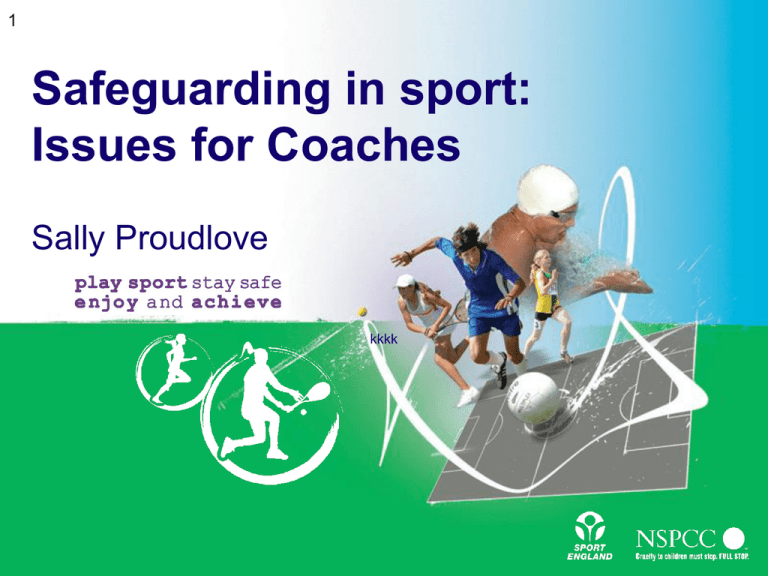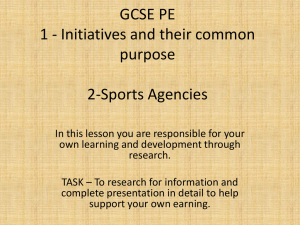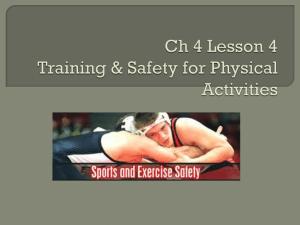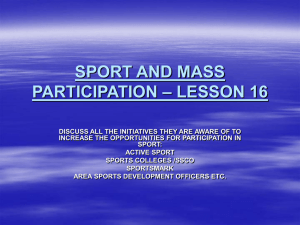Presentation: Sally Proudlove
advertisement

1 Safeguarding in sport: Issues for Coaches Sally Proudlove kkkk 2 Where we started 1990s – first high profile cases in sport Criminal convictions of Olympic and other elite sports coaches for sexual and physical abuse of athletes Multiple victims Intense media attention Reputational damage to sports bodies and loss of sponsorship Initial responses geared to dealing with rogue individuals not systematic change 3 4 Child Protection in Sport Unit Mission: To build the capacity of sport to safeguard children and young people in and through sport to enable sport to lead the way in keeping children safe from harm. 5 Role of CPSU Lead voice/champion/pioneer for safeguarding children in sport Enabler/facilitator/advisor to sports organisations Co-ordinator/influencer promoting messages and influencing policy Independent expert anticipating and interpreting national safeguarding developments 6 What’s the difference between safeguarding and child protection? • Safeguarding refers to the actions we take to promote the welfare of all children involved in our clubs and activities. • Child protection is an important element of safeguarding for specific children who are at risk of or are suffering significant harm. 7 Coach/player relationship • Position of trust • Imbalance of power, for example - playing time - opportunities for success - culture of the club • Opportunity to teach, encourage and build up 8 UK High Profile Convictions Hickson – swimming 1993 Rix – football 1999 Pratt – football 2000 Drew – swimming 2001 Pedrazzini – swimming 2001 Roebuck – cricket 2001 Griffin – karate 2001 Jones – swimming 2002 Smith – gymnastics 2004 Lloyd – tennis 2004 Fulwood – tennis 2005 Chamings – golf 2006 Clarke – swimming 2006 Lyte – tennis 2007 Phelps – diving/gymnastics 2008 Challis – trampolining 2008 9 What does research tell us? • • • • • Most studies recent – 1990s onwards Most focus on female experiences of abuse Most studies focus on sexual exploitation only Few countries have done research/quality variable There is a significant knowledge/practice gap 10 Risk factors • The higher the performance level, the greater the risk of sexual abuse in a sports context • Males, especially coaches, are responsible for most sexual abuse • Bullying/harassment by peer athletes is greater than that by coaches 11 Centre for Learning in Child Protection – Research 2011 The experiences of children participating in organised sport in the UK Kate Alexander Anne Stafford 12 Headline findings Overall, participating in organised sport Is a positive experience for most children and young people. However a negative sporting culture exists, is accepted as “the norm” and is perpetuated by peers, coaches and other adults. 13 Headline findings Young people in the study reported widespread emotionally harmful treatment (75%)and unacceptable levels of sexual harassment (29%). Clothing and body image are key issues within sport contexts particularly around puberty and warrant further attention. Self-harm was reported equally by both boys and girls (10%). Reports of sexual harm featured at a low level (3%) 14 Headline findings Peers were the most common perpetrators of all forms of harm reported in the research, with coaches sometimes failing to challenge it effectively. Coaches were the second most common perpetrators of harm with their role in harm increasing as young athletes advanced through the competitive ranks. 15 Experiences of various types of harm All Male Female Emotional harm 75% 77% 74% Self harm 10% 9% 10% Sexual harassment 29% 17% 34% Sexual harm 3% 5% 2% Physical harm 24% 26% 23% Total 100% 100% 100% Total (n) 6060 1634 4426 16 I mean the whole training was like, if you do one thing wrong then suddenly like you are being screamed at in the middle of an entire gym whether there is five year olds in there, or just your team in there. You are pointed out, isolated out, whether it's sent out the gym or just like screamed at or laughed at in front of the entire club (Young woman: international gymnastics). 17 We had a competition in training called… we called it juice boy basically, just a penalty shoot-out and the loser has to wear a pretty pink helmet the next time they go on the ice. There was one occasion where the goalies were told to let everybody score except this one kid (Young man: district level icehockey, local level football). 18 I didn’t like how they would grab you to show you how to do something. I hated that.…. I was a coach after I left school and we were taught how to show children to do something without touching them. And we were told always to ask first if we wanted to touch a child to show them something (Young woman: district level swimming, recreational gymnastics). 19 If you were injured, you weren’t allowed to stop. The coaches would guilt me into continuing. They would say things like, if you leave you’ll affect the numbers of the sides…They’d tell me I was letting the others down (Young woman: local level rounders, recreational hockey). 20 General messages Sport should focus more on a children’s rights approach to sport participation; and greater attention should be paid to creating a positive sporting ethos where children and young people are respected, and where their voices are heard and used to shape sporting experience, welfare and performance Sport should build on what children and young people value about sport participation. This includes the social aspects of sport such as making friends and being part of a team 21 General messages Sport should take steps to promote a more positive sporting and coaching ethos, at all levels of participation and in all sports Sports bodies should put in place policies, procedures, training and practice which enable sport practitioners to systematically tackle harm occurring between peers Sports bodies should use the findings and messages from the research to shape an examination of the culture in their own sport and address short-comings. 22 Safeguarding our elite athletes 23 Elite Athletes • Intense training regimes – separate athletes from peers in time & space • Rewards linked to compliance, performance – highest risk at ‘stage of imminent achievement • At greater risk of all forms of abuse 24 Safeguarding additionally vulnerable children in sport 25 Disabled Children in Sport • 4 times more likely to suffer abuse • Challenge of access to sport • Coaches and sports clubs can feel out of their depth.






